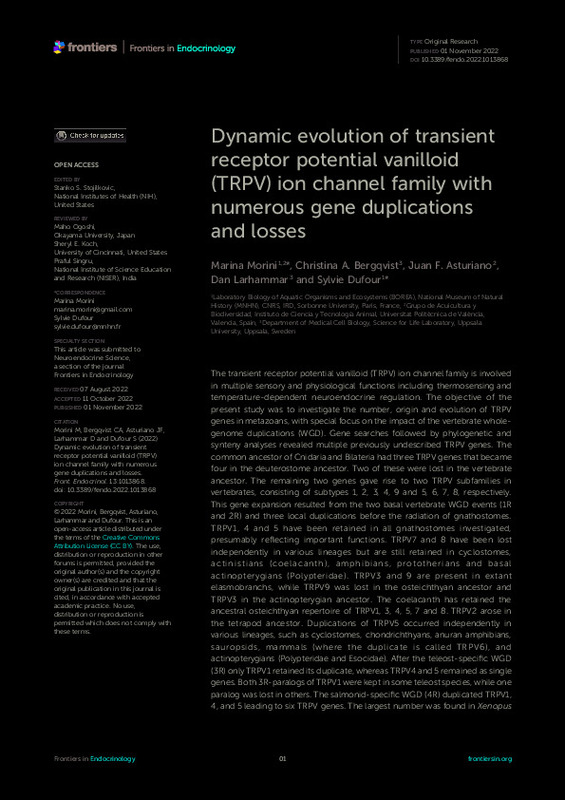JavaScript is disabled for your browser. Some features of this site may not work without it.
Buscar en RiuNet
Listar
Mi cuenta
Estadísticas
Ayuda RiuNet
Admin. UPV
Dynamic evolution of transient receptor potential vanilloid (TRPV) ion channel family with numerous gene duplications and losses
Mostrar el registro sencillo del ítem
Ficheros en el ítem
| dc.contributor.author | MORINI, MARINA
|
es_ES |
| dc.contributor.author | Bergqvist, Christina A.
|
es_ES |
| dc.contributor.author | Asturiano, Juan F.
|
es_ES |
| dc.contributor.author | Larhammar, Dan
|
es_ES |
| dc.contributor.author | Dufour, Sylvie
|
es_ES |
| dc.date.accessioned | 2023-07-04T18:01:27Z | |
| dc.date.available | 2023-07-04T18:01:27Z | |
| dc.date.issued | 2022-11-01 | es_ES |
| dc.identifier.uri | http://hdl.handle.net/10251/194668 | |
| dc.description.abstract | [EN] The transient receptor potential vanilloid (TRPV) ion channel family is involved in multiple sensory and physiological functions including thermosensing and temperature-dependent neuroendocrine regulation. The objective of the present study was to investigate the number, origin and evolution of TRPV genes in metazoans, with special focus on the impact of the vertebrate whole-genome duplications (WGD). Gene searches followed by phylogenetic and synteny analyses revealed multiple previously undescribed TRPV genes. The common ancestor of Cnidaria and Bilateria had three TRPV genes that became four in the deuterostome ancestor. Two of these were lost in the vertebrate ancestor. The remaining two genes gave rise to two TRPV subfamilies in vertebrates, consisting of subtypes 1, 2, 3, 4, 9 and 5, 6, 7, 8, respectively. This gene expansion resulted from the two basal vertebrate WGD events (1R and 2R) and three local duplications before the radiation of gnathostomes. TRPV1, 4 and 5 have been retained in all gnathostomes investigated, presumably reflecting important functions. TRPV7 and 8 have been lost independently in various lineages but are still retained in cyclostomes, actinistians (coelacanth), amphibians, prototherians and basal actinopterygians (Polypteridae). TRPV3 and 9 are present in extant elasmobranchs, while TRPV9 was lost in the osteichthyan ancestor and TRPV3 in the actinopterygian ancestor. The coelacanth has retained the ancestral osteichthyan repertoire of TRPV1, 3, 4, 5, 7 and 8. TRPV2 arose in the tetrapod ancestor. Duplications of TRPV5 occurred independently in various lineages, such as cyclostomes, chondrichthyans, anuran amphibians, sauropsids, mammals (where the duplicate is called TRPV6), and actinopterygians (Polypteridae and Esocidae). After the teleost-specific WGD (3R) only TRPV1 retained its duplicate, whereas TRPV4 and 5 remained as single genes. Both 3R-paralogs of TRPV1 were kept in some teleost species, while one paralog was lost in others. The salmonid-specific WGD (4R) duplicated TRPV1, 4, and 5 leading to six TRPV genes. The largest number was found in Xenopus tropicalis with no less than 15 TRPV genes. This study provides a comprehensive evolutionary scenario for the vertebrate TRPV family, revealing additional TRPV types and proposing a phylogeny-based classification of TRPV across metazoans. | es_ES |
| dc.description.sponsorship | MM is a recipient of France-Spain bilateral postdoctoral fellowship APOSTD (APOSTD/2020/053) from the Generalitat Valenciana and the European community. JA has funding from Spanish MICIU (Project EELGONIA; RTI2018-096413-B-I00). DL has funding from the Swedish Research Council and the Swedish Brain Foundation. SD has funding from MNHN and CNRS. | es_ES |
| dc.language | Inglés | es_ES |
| dc.publisher | Frontiers Media | es_ES |
| dc.relation.ispartof | Frontiers in Endocrinology | es_ES |
| dc.rights | Reconocimiento (by) | es_ES |
| dc.subject | Transient receptor potential channel | es_ES |
| dc.subject | TRPV | es_ES |
| dc.subject | Metazoans | es_ES |
| dc.subject | Vertebrates | es_ES |
| dc.subject | Evolution | es_ES |
| dc.subject | Phylogeny | es_ES |
| dc.subject | Synteny | es_ES |
| dc.subject | Tetraploidization | es_ES |
| dc.subject.classification | PRODUCCION ANIMAL | es_ES |
| dc.title | Dynamic evolution of transient receptor potential vanilloid (TRPV) ion channel family with numerous gene duplications and losses | es_ES |
| dc.type | Artículo | es_ES |
| dc.identifier.doi | 10.3389/fendo.2022.1013868 | es_ES |
| dc.relation.projectID | info:eu-repo/grantAgreement/AEI/Plan Estatal de Investigación Científica y Técnica y de Innovación 2017-2020/RTI2018-096413-B-I00/ES/DESARROLLO Y APLICACION DE LAS TECNICAS DE PRODUCCION SUBROGADA DE GAMETOS DE ANGUILA EUROPEA MEDIANTE XENOTRASPLANTE DE ESPERMATOGONIAS EN OTRAS ESPECIES DE PECES/ | es_ES |
| dc.relation.projectID | info:eu-repo/grantAgreement/UPV-VIN//PAID-01-20-21//Desarrollo y aplicación de las técnicas de producción subrogada de gametos de anguila europea mediante xenotrasplante de espermatogonias en otras especies de peces (EELGONIA)./ | es_ES |
| dc.relation.projectID | info:eu-repo/grantAgreement/GVA//APOSTD%2F2020%2F053/ | es_ES |
| dc.rights.accessRights | Abierto | es_ES |
| dc.contributor.affiliation | Universitat Politècnica de València. Escuela Técnica Superior de Ingeniería Agronómica y del Medio Natural - Escola Tècnica Superior d'Enginyeria Agronòmica i del Medi Natural | es_ES |
| dc.description.bibliographicCitation | Morini, M.; Bergqvist, CA.; Asturiano, JF.; Larhammar, D.; Dufour, S. (2022). Dynamic evolution of transient receptor potential vanilloid (TRPV) ion channel family with numerous gene duplications and losses. Frontiers in Endocrinology. 13:1-23. https://doi.org/10.3389/fendo.2022.1013868 | es_ES |
| dc.description.accrualMethod | S | es_ES |
| dc.relation.publisherversion | https://doi.org/10.3389/fendo.2022.1013868 | es_ES |
| dc.description.upvformatpinicio | 1 | es_ES |
| dc.description.upvformatpfin | 23 | es_ES |
| dc.type.version | info:eu-repo/semantics/publishedVersion | es_ES |
| dc.description.volume | 13 | es_ES |
| dc.identifier.eissn | 1664-2392 | es_ES |
| dc.identifier.pmid | 36387917 | es_ES |
| dc.identifier.pmcid | PMC9664204 | es_ES |
| dc.relation.pasarela | S\473704 | es_ES |
| dc.contributor.funder | Brain Foundation | es_ES |
| dc.contributor.funder | Generalitat Valenciana | es_ES |
| dc.contributor.funder | Swedish Research Council | es_ES |
| dc.contributor.funder | Agencia Estatal de Investigación | es_ES |
| dc.contributor.funder | UNIVERSIDAD POLITECNICA DE VALENCIA | es_ES |
| dc.contributor.funder | Centre National de la Recherche Scientifique, Francia | es_ES |
| dc.subject.ods | 14.- Conservar y utilizar de forma sostenible los océanos, mares y recursos marinos para lograr el desarrollo sostenible | es_ES |








